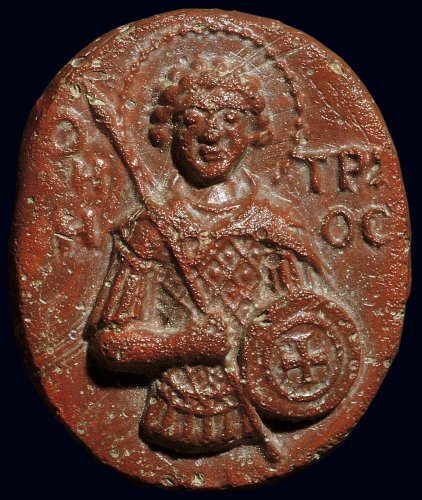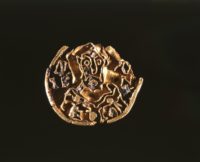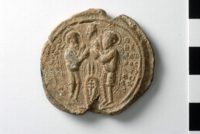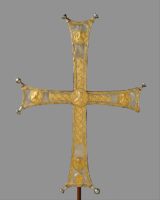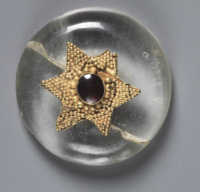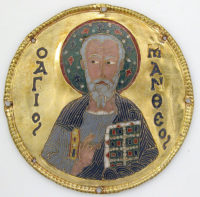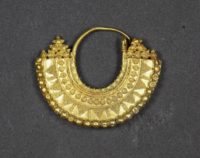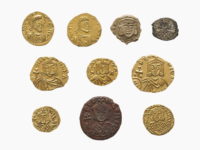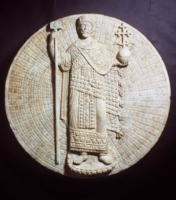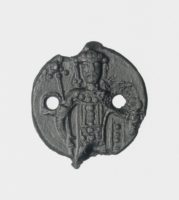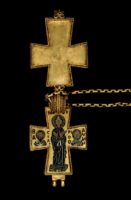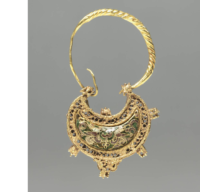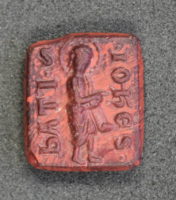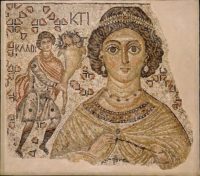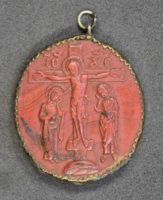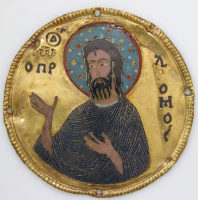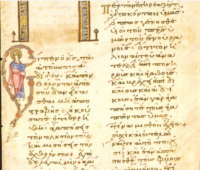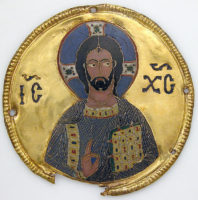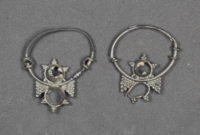Oval cameo of glass paste, with a representation of St Dimitrios. Period: Middle Byzantine; circa: 12th c. Materials: glass. Made in: Constantinople. The Benaki Museum of Greek Culture is housed in one of the most beautiful neoclassical-style buildings in Athens, near the National Garden and the Hellenic Parliament. It was converted into a museum in order to shelter the collections of Antonis Benakis and was donated to the Greek nation by himself and his three sisters, Alexandra, Penelope and Argine. Following its most recent refurbishment (1989–2000), the building houses a unique exhibition on Greek culture arranged diachronically from prehistory to the 20th century.
Vollschmelz medallion (9th Century – Middle Byzantine Period). Gold cloisonné; bust of St. Nicholas, his right hand raised in benediction, a book in his left; inscription. British Museum is closed 24, 25 and 26 December and 1 January, but is open every other day of the year. Fast facts about the British Museum: Founded: 1753, Collection size: 8 million objects, Oldest object in the collection: Stone chopping tool (nearly 2 million years old).
Seal, Theodore Kastamonites, Sebastos. The two Saints Theodore standing with their hands upraised towards the manus Dei above. Between them are their spears and a shield embossed with a patriarchal cross. This remarkable seal may well have belonged to Theodore Kastamonites, the maternal uncle of the emperor Isaac II Angelos (1185–1195, 1203–1204), who tended to the internal affairs of the empire during his nephew’s first reign. The museum is open to the public Tuesday through Sunday, 11:30 a.m.–5:30 p.m., except for federal holidays.
Processional Cross, Period: Middle Byzantine, circa: 1000–1050, Materials: Silver, silver-gilt. On view at The Met Fifth Avenue in Gallery 303. Inscription: in Greek: (on the back medallions) Saint Thalelaios, Saint Nicholas, [initials for] Saint John Chrysostom, Uriel, Raphael; (on foot) supplication of Leo, bishop (on the front medallions) [initials for] Jesus Christ, [initials for] Mother of God, [initials for] John the Forerunner, Michael, Gabriel. The Metropolitan Museum of Art (New York) is one of the world’s largest and finest art museums. Its collection includes more than two million works of art spanning five thousand years of world culture, from prehistory to the present and from every part of the globe. Public Hours: 10:30 a.m.–5:30 p.m. Open seven days a week.
Button, Early Byzantine circa: 500s. Materials: Rock crystal with a garnet mounted in a gold granulated star. The Cleveland Art Museum Hours: Tuesdays, Thursdays, Saturdays, Sundays 10:00 a.m.–5:00 p.m. Wednesdays, Fridays 10:00 a.m.–9:00 p.m. Closed Mondays.
Medallion with Saint Matthew from an Icon Frame, Period: Middle Byzantine, circa: ca. 1100, Made in Constantinople, Materials: Gold, silver, and enamel worked in cloisonné, Dimensions: Diam: 3 1/4 in. (8.3 cm) Mount: 20 1/2 x 15 x 7/8 in. (52.1 x 38.1 x 2.2 cm), The Metropolitan Museum of Art (New York) is one of the world’s largest and finest art museums. Its collection includes more than two million works of art spanning five thousand years of world culture, from prehistory to the present and from every part of the globe. Public Hours: 10:30 a.m.–5:30 p.m. Open seven days a week.
Gold Earring; semi-circular; with U-shaped loop to which is attached a similarly shaped thin plate of gold. Period: Middle Byzantine; 11thc.-12thc.; Found/Acquired: Syria. British Museum is closed 24, 25 and 26 December and 1 January, but is open every other day of the year.
Coins, Ruler: Theophilus, Byzantine Emperor; Period: Middle Byzantine circa: 821-842; Minted in: Italy. Weight: 4.413 grammes. British Museum is closed 24, 25 and 26 December and 1 January, but is open every other day of the year. Fast facts about the British Museum: Founded: 1753, Collection size: 8 million objects, Oldest object in the collection: Stone chopping tool (nearly 2 million years old).
Roundel with Emperor John II Comnenus. Period: Byzantine, ca. 1110 – 1118. Material: marble. The museum is open to the public Tuesday through Sunday, 11:30 a.m.–5:30 p.m., except for federal holidays.
Molivdovul. Manuel I Comnenus, Period: Middle Byzantine, circa: 1143-1180. Material: lead. The collection of the State Hermitage includes over 3 million works of art and world culture artefacts. It contains paintings, graphic works, sculptures, works of applied art, archaeological artefacts and numismatic objects. The Hermitage is considered to have been founded in 1764, when Empress Catherine the Great acquired an impressive collection of works from the Berlin merchant Johann Ernst Gotzkowsky. The museum celebrates the anniversary of its founding each year on 7 December, St. Catherine’s Day. Opening Hours: Tuesday, Thursday, Saturday, Sunday: 10.30-18.00 Wednesday, Friday: 10.30-21.00 Closed: Monday.
Dish of brown, fine-grained clay covered with a white slip. Period: Middle Byzantine; circa: Late 12th-early 13th c. The decoration is in champlevé, while the individual details are incised. A large standing bird is pictured between two bird-shaped animals resembling griffons but without wings. Dimensions: H. 0.07, Diam. of rim 0.235, Diam. of base 0.08 m. On the ground tufted plants. Yellow, very good quality glaze covers the inner surface and the edge of the rim on the outside. The Benaki Museum of Greek Culture is housed in one of the most beautiful neoclassical-style buildings in Athens, near the National Garden and the Hellenic Parliament.
Reliquary Cross; Materials: Cloisonné Enamel and Gold, Period: Middle Byzantine (10thc.) Made in: Constantinople. Museum Description: “Decorated with a standing figure of the Virgin, wearing chiton and maphorion, flanked by busts of St Basil and St Gregory Thaumaturgus; cylindrical gold chain connected to pendant; part of chain in another style.” British Museum is closed 24, 25 and 26 December and 1 January, but is open every other day of the year. Fast facts about the British Museum: Founded: 1753, Collection size: 8 million objects, Oldest object in the collection: Stone chopping tool (nearly 2 million years old).
Crescent-Shaped Earring, Materials: Gold filigree with cloisonné enamel. Period: Middle Byzantine circa: 1000-1100. Dimensions: 2.3 x 2.6 cm (7/8 x 1 in.). The Cleveland Art Museum Hours: Tuesdays, Thursdays, Saturdays, Sundays 10:00 a.m.–5:00 p.m. Wednesdays, Fridays 10:00 a.m.–9:00 p.m. Closed Mondays.
Gold coin, Ruler: Tiberius III, 705-711, Minted in: Ravenna, Weight: 4.238 grammes. British Museum is closed 24, 25 and 26 December and 1 January, but is open every other day of the year. Fast facts about the British Museum: Founded: 1753, Collection size: 8 million objects, Oldest object in the collection: Stone chopping tool (nearly 2 million years old).
Cameo; red glass; quadrangular; Period: 13thC, Late Byzantine. Figure of St John the Baptist in relief with inscription. Made in: Venice. British Museum is closed 24, 25 and 26 December and 1 January, but is open every other day of the year.
Fragment of a Floor Mosaic with a Personification of Ktisis, Period: Early Byzantine circa: 500–550, with modern restoration. Materials: Marble and glass. The Metropolitan Museum of Art (New York) is one of the world’s largest and finest art museums. Its collection includes more than two million works of art spanning five thousand years of world culture, from prehistory to the present and from every part of the globe. Public Hours: 10:30 a.m.–5:30 p.m. Open seven days a week.
Glass Cameo, Period: Late Byzantine; circa: 13th century A.D. Brick-red, opaque; on the front, the Crucifixion with, the Virgin at left, St John at right. Set in a metal frame. Diameter: 51 millimetres. British Museum is closed 24, 25 and 26 December and 1 January, but is open every other day of the year. Fast facts about the British Museum: Founded: 1753, Collection size: 8 million objects, Oldest object in the collection: Stone chopping tool (nearly 2 million years old).
Medallion with Saint John the Baptist from an Icon Frame, Period: Middle Byzantine, circa: 1100, Made in Constantinople, Materials: Gold, silver, and enamel worked in cloisonné. On view at The Met Fifth Avenue in Gallery 303. The Metropolitan Museum of Art (New York) is one of the world’s largest and finest art museums. Its collection includes more than two million works of art spanning five thousand years of world culture, from prehistory to the present and from every part of the globe. Public Hours: 10:30 a.m.–5:30 p.m. Open seven days a week.
Opening of Gospel of Matthew. Period: Middle Byzantine. 1063 A.D. The museum is open to the public Tuesday through Sunday, 11:30 a.m.–5:30 p.m., except for federal holidays.
This medallion of Christ is from a group of twelve that once surrounded an icon of the archangel Gabriel. Period: Middle Byzantine, circa: ca. 1100, Made in Constantinople, Materials: Gold, silver, and enamel worked in cloisonné. The Metropolitan Museum of Art (New York) is one of the world’s largest and finest art museums. Its collection includes more than two million works of art spanning five thousand years of world culture, from prehistory to the present and from every part of the globe. Public Hours: 10:30 a.m.–5:30 p.m. Open seven days a week.
Pair of earrings, Period: Middle Byzantine (10thC-11thC). Material: silver. Diameter: 3.4 centimetres (max). British Museum is closed 24, 25 and 26 December and 1 January, but is open every other day of the year. Fast facts about the British Museum: Founded: 1753, Collection size: 8 million objects, Oldest object in the collection: Stone chopping tool (nearly 2 million years old).


